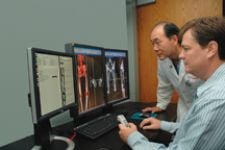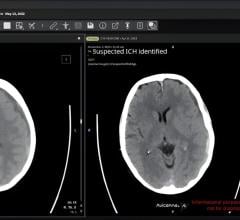
Image exchange between facilities is a challenge for storage solutions.
Making a large initial investment in a storage archive solution is usually not a priority for facilities strapped for capital budgets. Still, there is increased pull for general digital imaging and archiving solutions because data storage has become business critical.
A number of vendors highlight the application service provider (ASP) aspect of their storage offerings, allowing customers to store their data at offsite data centers. These firms tout the pay-per-study financial convenience and disaster recovery benefits of ASP services as well. Grid computing technologies is also attracting growing interest, particularly from healthcare facilities facing scalability and economical challenges of long-term archiving.
So which solution is truly cost-effective, with a low cost of ownership, yet still scalable?
Imaging Technology News asked industry IT experts to sketch the best blueprint for building a cost-effective storage archive solution.
These experts included Lee Goldman, M.S., DABR, chief of physics and engineering, department of radiology, Hartford Hospital; Leslie M. Beidleman, PACS Administrator/Mercy Health Partners (MHP), St. Vincent Mercy Medical Center; Robin Purohit, vice president and general manager, information management, Hewlett-Packard; Mitchell Goldburgh, senior vice president of marketing and business development, InSite One; and Houssein Pourmand of Candelis, vice president of business development, Candelis.
What are the challenges you see healthcare facilities facing when it comes to managing their data?
Goldman: The biggest problem in storage that I see, which is going to become worse in the future, is interchange of data between facilities that have PACS because we go through the process of the patient having a CT, and then if you want that to be accessible to all of the physicians in your institution, you have to load that into your PACS, which means you need to make the patient demographics match. It’s going to get worse as more facilities put the images on PACS. The problem is that there is no access.
How do you see the medical imaging archiving market growing in dollars?
Purohit: There is at least about $300 million dollars that is spent every year in storage solutions. All of this information represents intellectual property. Hospitals have to retain it for compliance purposes, but they want to see and reuse it. So retrieval time is a hot topic with every customer that we have. Retrieval time is all about having an optimal online solution versus a WORM optical or tape archiving solution.
Goldburgh: Continued growth in cardiology sites is in direct response to the continued growth in this area brought about by a generation of archives that are becoming obsolete. The breadth of data within cardiology requires high-performance solutions for ready access to archived studies whether the exam is a 256-slice CT scan or a digital echocardiogram. [Our] archive supports optimized data management with partner applications that can address the long-term storage of large data sets inherent in cardiology digital imaging.
Healthcare facilities are concerned more than ever with reducing the total cost of ownership. What are some strategies for reducing costs without sacrificing scale?
Pourmand: While the actual cost of storage has been declining, the challenge facing IT and PACS administrators has been to implement solutions (hardware and software), which can accommodate large studies from 64-slice CTs, Dual Source CTs and 256-slice CTs. Unfortunately, a general purpose storage solution may not be able to handle this challenge when it comes to medical images.
Any imaging facility is focused on costs, both upfront costs as well as on-going costs such as service and support, networking, security, user training and software licensing fees. [You can lower] the total cost of ownership with low, disruptive pricing for installation, training, data migration, support and maintenance; tape library for Information Lifecycle Management to reduce the cost of archiving; lowering operational costs such as ongoing labor and management costs; and by minimizing system downtime with proactive monitoring capability to ensure that key components are operating optimally.
Purohit: One of the things we have heard from our customers is that they are all strapped for capital budgets, so we have reduced the cost structure by 30-40 percent for that initial solution. This is a real benefit for smaller to mid-range hospitals.
As customers grow, they want to put these images on different kinds of storage. So they are asking for a wider variety of storage connectivity they can put behind their system, and particularly as they grow very large to put it on the storage area network itself. We support these high-end storage networks, which give you incredible storage capabilities and also make it much easier to migrate an image from a high-performance storage device to a lower-performance storage device, so you’re always optimizing the cost.
What are some of the advantages of grid storage?
Pourmand: Fault-tolerance is one of the inherent advantages of a grid-architected storage solution. Multilocation healthcare facilities can cost effectively deploy an easily scalable ImageGrid at each location and without any special software or protocols elsewhere on their network or PACS and archive studies in a distributed manner.
By using replication capability and a routing engine, all studies will be available at all times to any PACS server or client on the LAN or WAN. This type of an environment provides for high availability of data as well as providing disaster recovery and data back-up capabilities.
Purohit: Grid storage architecture we found in general is the best way to scale up in a cost-effective way and to provide a high degree of availability. Even in other products outside of healthcare we use grid storage capability for high-performance computing and for large-scale eMail archiving for regulatory compliance. We consistently hear from our customers that it is a nice modular way of upscaling and creating any connectivity to get a high level of disaster recovery. We are completely sold on that being the right approach.
You also want to have the backend SAN-compatible because of these large- scale images, so that helps with the sheer amount of storage, but the brick-by-brick approach allows the customer to start small and scale up incrementally as their needs grow without sacrificing the high levels of availability and performance.
With storage for medical images and data growing from 20 Terabytes of data to 200 in the next few years, how can facilities scale up efficiently?
Pourmand: An appliance O/S, as compared to a general purpose O/S, reduces and for the most part eliminates administrative interaction with the O/S and database. In addition, by using Linux, our image grid is not only highly scalable in terms of the underlying processing capabilities but also enables us to introduce the latest hardware and O/S combination rapidly, while having access to the source code, which is not the case with Microsoft-based solutions. Tightly integrated hardware and software allows for delivering a “plug-and-play” appliance.
There is also an optimized data path capable of archiving and managing large medical imaging studies and a Web-based and intuitive administrative user interface allowing for easy system set-up and management.
Purohit: We focus very much on a factory-integrated approach by packaging all of the technology together to make it easier for the user to deploy. So we deliver the opportunity to get the lowest cost from a capital perspective because we are the cost leader on that side, and we give them a much simpler management experience because we’re delivering a factory-integrated solution on site.
[Other vendors] tend to take the more custom approach, so they have to do a lot of work with services or on their own to construct the overall solution. What we have heard from those customers is that it looks good initially, but as it grows the cost of management gets way out of control. With us you can start small, you open up the backend and get to that extra availability.
Beidleman: In late 2007, Carestream Health worked with us to install a 13 node EMC Centera for an additional 30 Terabytes of storage. During this timeframe MHP added cardiology to the storage archive and is in the process of migrating the data on the two tape libraries to the Workgroup server. We also plan to store oncology data from the new cancer treatment center and radiation therapy data on this central storage archive.
What are the solutions for providing secure system-wide access to images?
Beidleman: At MHP, the Carestream Health solution used a unique ID across our three main facilities to create system-wide identification of patients. This same plan has been rolled out to the other facilities that have been added to the PACS. Carestream Health worked with MHP to build storage plans based on the unique ID. These storage plans automatically direct the movement of data based on instructions specific to the type of study and retention requirements. MHP physicians can now access images across the region using one patient number.
How can a storage solution help increase throughput?
Pourmand: The profitability of an imaging practice is improved through a lower long-term archiving cost and the radiologist’s ability to quickly and efficiently access prior studies.
Healthcare facilities can cost effectively archive more of their studies and patient records on a RAID-based solution and thereby have always-online access to them; have high availability due to a fault-tolerant grid architecture; implement a disaster recovery strategy by leveraging the grid architecture; and implement an Information Lifecycle Management strategy using tape libraries as a fully integrated software-hardware solution.
Purohit: Part of the throughput is addressed by very high-performance caching technology, distinguished by its ability to retrieve these images very quickly. Now with the SAN behind this product, we can move the images that don’t need to be moved as fast onto lower tiers of storage. And they can always be moved back if you want real-time access to a patient’s record. By moving certain images off the highest performance storage means you can get the things you do want back very quickly.
On an image-by-image basis, we have the ability to define policy to balance between speed and retention time. So image data is all sitting up on the most appropriate storage with one integrated management system.
Beidleman: Radiologists can read more efficiently since they can now access a complete patient history. Hospital clinicians and referring physicians are able to view radiology studies from all MHP locations via one Web viewer, and they have access to all patient studies for the last five years across three facilities.
Recently, two additional rural facilities have been brought up on PACS. Their studies are backed up to a central server, which gives physicians true regional access to patient radiology studies. Cardiologists have also seen improvements in productivity since they can now retrieve studies in seconds and no longer have to insert DVDs.
When can a facility usually expect a return on their investment?
Pourmand: A paradigm shift in medical image management and archive is considered a disruptive innovation. Disruptive price allows customers to see a return on their investment in less than one year and in many cases less than six months.
Purohit: For Asante Health Systems, they had an ROI calculation of 250 percent over five years and initial cost savings going from the customer approach to the SAN approach of $1.8 billion right up front.
So a good capital savings right up front. Everyone is under tremendous cost pressures, so you have to demonstrate these numbers.
What is the best strategy for future growth?
Purohit: Start small because if you’re not there today, you’re probably not going to get a huge capital budget to invest tomorrow.
Grow incrementally as you need with the grid architecture. You can always place the data on the most appropriate storage, balancing retention and performance on an image-by-image level.
Now that images are business-critical capable, share this among your network of hospitals or service providers, making sure this a highly available solution.



 December 01, 2025
December 01, 2025 









